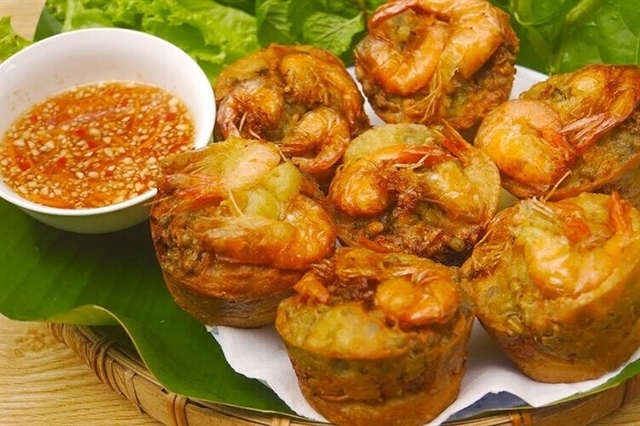 Features
Features

Founded in the 11th century under Lý Dynasty, Đồng Ngư Village’s unique form of water puppetry continues to draw crowds today, with unparalleled mystery, mastery and committment from its performers.
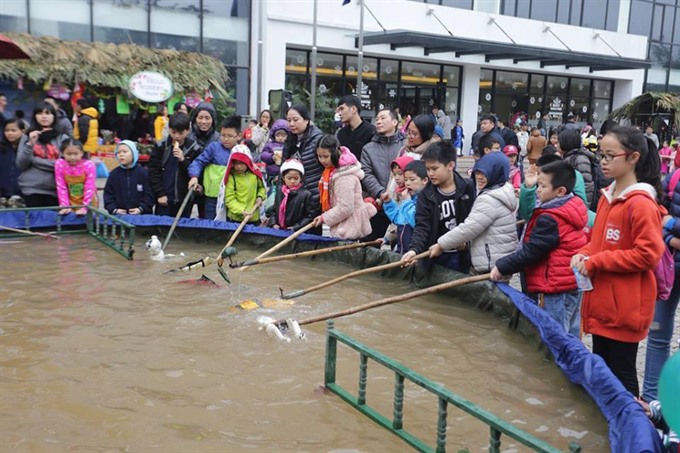 |
| Giving it a try: Kids in the audience get basic lessons in water puppetry. VNS Photo Trương Vị |
Founded in the 11th century under Lý Dynasty, Đồng Ngư Village’s unique form of water puppetry continues to draw crowds today, with unparalleled mystery, mastery and committment from its performers.
By Minh Thu
Rotund and jolly looking, Tễu, narrator of the play, invites the audience in the traditional way, offering them betel leaves and areca nuts to chew.
The children are most excited at receiving the betel leaf and areca nut, though they cannot consume it.
They are excited because Tễu is walking on water, gliding rather, and even jumping/bobbing a bit to the cheerful, lively music in the background.
Tễu is a water puppet who can go farther than other traditional peers because his puppeteer uses a system of pulleys and wires rather than the stiff bamboo poles usually used in traditional water puppetry.
This sophisticated technique, a precursor to the modern robot, is particular to Đồng Ngư Village in the northern province of Bắc Ninh.
The greater reach and flexibility of the technique also allows Tễu to offer flowers to distinguished guests attending the play during ceremonies held before the play starts.
Villagers in the Red River Delta and other rice-growing regions in the north of Việt Nam have for long staged water puppet performances to celebrate the end of the rice harvest, at religious festivals and other important occasions.
Founded in the 11th century under the Lý Dynasty, Đồng Ngư Village’s unique style of water puppetry continues to draw crowds today, the mastery and commitment from its performers able to entertain people of all ages from all walks of life.
An accident
Today, Nguyễn Thành Lai is considered the most active artisan devoted to preserving and promoting the traditional art. At 47, he is old enough to be experienced and young enough to enthusiastically organise performances and introduce the Đồng Ngư Village water puppetry style to audiences nationwide.
Though Lai was born in the cradle of water puppetry, he took it up as a career by accident. He was a mechanic who repaired cars in Hà Nội.
In 2000 he was involved in an accident and returned to Đồng Ngư Village to recuperate. In those days, he spent his free time watching old artisans perform and manipulate the puppets. He was so fascinated that it changed his life, totally.
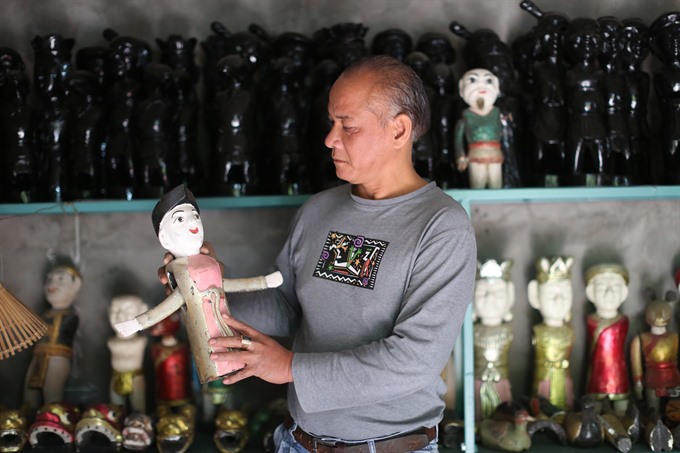 |
| Holding firm: Nguyễn Thành Lai is considered the most active artist in preserving and promoting the unique form of water puppetry in Dong Ngu Village, Bac Ninh Province. VNS Photo Trương Vị |
He decided to learn seriously and become a water puppeteer. With his aptitude and experience for mechanical things, he soon became one among few artisans in the village to master the technique of making puppets.
“Most of Đồng Ngư villagers know how to control the puppets but there are not many people who can make them,” he said.
The water puppets are made of lacquered wood. The best wood to make the puppets is that of the cluster fig tree which is light, soft and durable , allowing the puppets to float easily on the water surface.
A confluence
Another unique aspect of Đồng Ngư puppetry, which makes it from other forms in the Red River Delta is the quan họ (love duets) songs that accompany the plays,” said Lai.
“Bắc Ninh Province is the cradle of quan họ singing. That’s the reason why we perform quan họ in most of our water puppetry plays.”
Tễu is the most notable character in water puppetry, telling stories and making people laugh with his actions. Lai and colleagues have created some new pieces, like the Mouse’s Wedding, inspired by the Đông Hồ folk painting, Mời Trầu (Offering Betel) and Fairies’ Dance.
Their repertoire includes classical pieces featuring historic legends and the daily life of Vietnamese farmers including buffalo fights, fishing, swimming contests and lion dances.
Once he became well versed in the art, Lai established his own Luy Lâu Water Puppetry Company in 2010 to preserve and promote the traditional art “in a modern and creative way.”
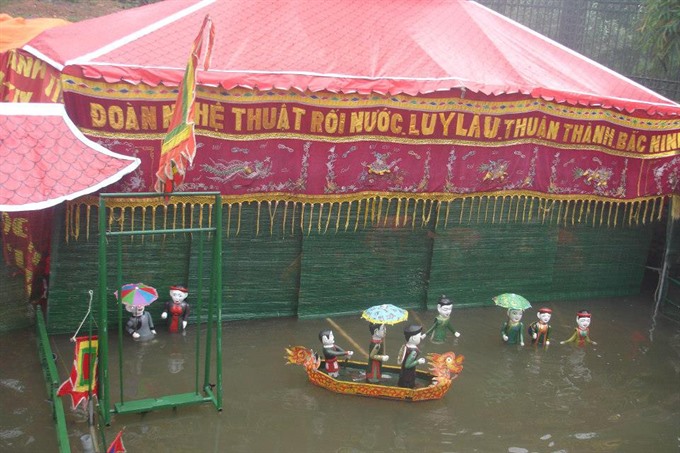 |
| The stage is set: A pavilion is set up in the middle of the middle of a pond, with puppeteers standing waist-deep in the water behind bamboo curtains. VNS Photo Trương Vị |
The troupe has created stable jobs for many artisans. His troupe has performed in many festivals, in their hometown and neighbouring regions. Besides, they have contracts to perform regularly at the Ethnic Minority Culture Museum in the northern province of Thái Nguyên, the Việt Nam Museum of Ethnology in Hà Nội and Tuần Châu Tourist Site in the northern province of Quảng Ninh.
“At the Tuần Châu Tourist Site, we perform six shows a day in summer and three shows a day in winter,” he said.
Dương Văn Giáo, 60, highly appreciates the efforts of young artisans like Lai. Without him, Đồng Ngư water puppetry would not have revived, he said.
While the Đồng Ngư water puppetry has a 1,000-year-old tradition with unique characteristics, like other traditional art forms, the wars that the nation was forced to fight destroyed all the puppets and the thủy đình (water pavilions – theatre for water puppetry, that would occupy the middle of the pond, with the puppeteers stand waist-deep in the water behind a bamboo curtain).
With many Đồng Ngư villagers serving in the army, the art disappeared for several decades.
Thanks to artisans of the Đồng Ngư Puppetry Guild and the Luy Lâu Water Puppetry Company, it has been revived, preserved and developed.
“We began to restore the art in 1985,” said Giáo. “We contributed bamboo and wood to build another thủy đình and make puppets.”
Giáo’s team performed at festivals held in the neighbouring villages. At the end of the performance, they insisted of being paid in equipment like loudspeakers instead of money, because it was expensive then.
Despite his age, Giáo doesn’t mind standing in the water for long periods of time, but said his hands are no longer strong enough to control the puppets for hours.
“But I’m willing to help Lai train the next generations of puppeteers professionally,” Giáo said.
“We have to aim to train an artisan to control all puppets. And all performers should be able to make and repair the puppets,” said Giáo.
Furthermore, in the future, small-sized puppets would be produced so that tourists and visitors can buy them as souvenirs, he said.
The artisan also said attention should be paid to training people in playing musical instruments and singing, because music was an integral part of a water puppetry performance.
Lai agreed. “Quan họ is a part of what distinguishes Đồng Ngư water puppetry,” he said.
“The live music brings forth emotions, inspires and excites both audiences and performers.
“The experienced singers can perform in harmony with the puppeters, even help them hide some errors. For example, once a puppeteer making Tễu climb the areca palm lost his grip and the puppet fell down. The singer immediately stopped the song and cried ‘ouch’. The audience didn’t realise the mistake. They believed that the fall is a part of the plot.”
Lai has had his daughter Nguyễn Mai Linh Hương, 13, learn ca trù (ceremonial singing) and quan họ. She’s become the youngest member of the troupe, singing together with the band as they accompany the water puppeteers.
"I have performed with my father’s troupe many times and I like the perfect harmony between the two folk art styles," she said.
"I actually prefer the playback singing to singing on stage.
“Children of Đồng Ngư Village love to play with the puppets since we are little, but it was only when I was 10 that I could start learning because my hands were not strong enough to control the puppets,” she said.
They often stuck flags on water hyacinth plants to make a stage for themselves and played with the puppets, she added.
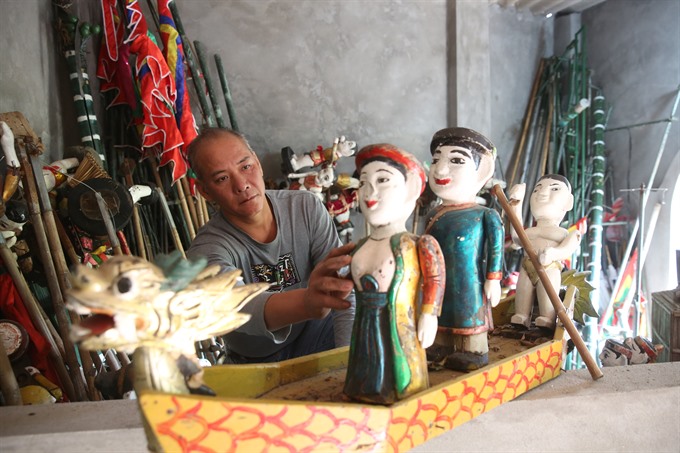 |
| Ready to sail: Lai prepares his puppets well before the show. He is one among few artisans who can make and repair the figurines. VNS Photo Trương Vị |
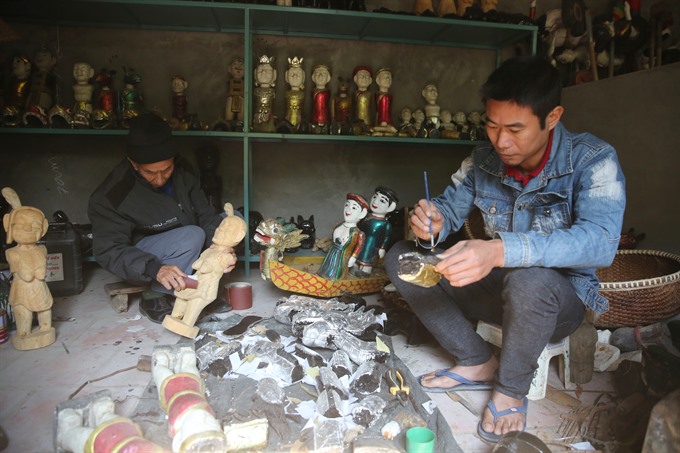 |
| Colourful addition: Nguyễn Đình Hiệp, 35, says controlling puppets with pulleys and strings is much more difficult than using bamboo poles. VNS Photo Trương Vị |
 |
| Hooked: Puppets are given a layer of paint to protect them from termites before they are lacquered. VNS Photo Trương Vị |
Much effort required
The artists do not divulge the secrets behind their impressive skills that keep audiences riveted.
To have a farmer jump on a buffalo without any sign of the puppet’s strings or other form of control takes a lot of patience and practice.
Nguyễn Đình Hiệp, 35, said controlling the puppets with pulleys and strings was much more difficult than using bamboo poles.
"One puppet can move by a dozen strings which can easily get tangled. If the puppeteer is careless, the puppets can get stuck and it can be impossible to disentangle them quickly on stage," he said.
“We use all our energy, concentration and emotions to make the puppets soulful and lively,” said Hiệp.
He said even harder than the performance was the preparatory work of setting up the stage.
“We perform for an hour, typically, but installing the stage can take several days and many hours soaking in the water. We have to prepare all the machines and equipment.
“It’s like a torture if we have to perform in cold weather, so before the performance we eat ginger and drink nước mắm (fish sauce) to keep the body warm,” said Hiệp.
Like other artists in the troupe, Hiệp dreams to have an indoor theatre for water puppetry in the village.
“Having a stable stage would help us a lot because we won’t have to set up the stage and dismantle everything at the end of the performance. It would save much time and effort.”
“On the other hand, if we have an indoor stage, we can take advantage of light and sound to make the show even more attractive and impressive.”
Hiệp said ruefully that when a performance is held during the day, the audience can spot mistakes as well as tricks used by the puppeteers.
“Like magic shows, when audiences don’t know the trick, it gets more fascinating.”
Promising future
Hiệp and other artists in Đồng Ngư Village won’t have to wait long to realise their dreams. The provincial People’s Committee has approved a VNĐ17 billion (US$750,000) plan to preserve and promote water puppetry, said Nguyễn Nho Thuận, vice chairman of the Culture and Information Bureau of Thuận Thành District.
“We will support Đồng Ngư Water Puppetry Guild and Luy Lâu Water Puppetry Company at the same time and create all good conditions for the artists to perform.”
“We will also continue to work on documents related to Đồng Ngư water puppetry to propose that the Ministry of Culture, Sports and Tourism recognises this art form as a National Intangible Heritage.”
Thuận said the local authorities understand the difficulties and efforts of the artisans. A project to building the Centre for Preserving and Promoting Đồng Ngư Water Puppetry will start next year and will be finished by 2020, he said.
The artisans will have a place to worship and pay tribute to the ancestors of the art, organise training courses, and display information and objects introducing the art.
The local authorities will also join hands with other partners, especially travel agents, to launch tours to discover the village’s beauty spots, cultural vestiges and traditional heritage of Thuận Thành District.
The tours will connect Đồng Ngư Village with neighbouring destinations like the Đông Hồ folk painting village, Dâu Pagoda and Keo Pagoda. — VNS


